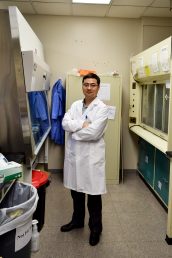Can liquid metals help in nerve repair?

Jie Xu, assistant professor of mechanical and industrial engineering, is working on a collaboration to study how electrodes in liquid metal form can assist with nerve repair.
Damaged nerves can be detrimental to a person’s health.
Unable to repair themselves or regrow, degenerative neurons cause things like paralysis and problems with motor function. Available and common treatment options have downsides. Medications don’t reverse the damage, and many surgeries that address disabilities caused by these neurons are major and high risk.
Researchers Xuejun Li and Jie Xu may have a better idea. As part of a new collaboration, they plan to test whether human motor neurons and muscle cells can be linked using liquid metals.
Their approach, which uses microfluidics or miniature devices for manipulating cells and regents, isn’t new, but what’s novel are the materials that Li and Xu will use for electrical stimulation of neurons — electrodes in liquid metal form.
Traditionally, electrodes are solid, but they can break easily in the human body.
“It’s not really a feasible type of material for nerve repair,” said Xu, assistant professor of mechanical and industrial engineering in the College of Engineering.
Liquid metals, which are alloys of a few metals, are flexible, stretchable and can self-heal. Some, like gallium, are non-toxic, he explained.
“We can use that to connect a stem cell, nerve cell and muscle cell together,” added Li, who holds the Michael A. Werckle, MD, Endowed Professorship in Biomedical Sciences.
If outcomes for their testing are successful, the researchers will examine their approach on animal models and human subjects — another first in the field — to validate the method, which could become a treatment option for people suffering from things like paralysis and other peripheral nerve injuries.
Li and Xu have already won $10,000 in seed funding from the Office of the Vice Chancellor for Research (OVCR) to gather preliminary data over the next 10 months.
“[The project proposal] demonstrates remarkable innovation,” said Lyndon Cooper, associate dean for research in the College of Dentistry. Cooper is a leader of functional and regenerative materials at UIC.
The group was formed to inspire discovery and cross-disciplinary work related to the university’s research strengths and priorities, which were identified in 2016 by OVCR, the university’s Research Advisory Council, Dean’s Council, Senate Research Committee and faculty, at the request of Chancellor Michael Amiridis. Other strengths include social justice, community disparities, urban infrastructure, the brain, personalized medicine/genomics and big data.
Li and Xu met at a speed networking event in January hosted by OVCR for functional and regenerative materials. They came up with their project idea in about six minutes.
“This project showed that two people with very independent, strong research programs could find one very, very focused arena to apply their efforts,” Cooper said. “It has the potential to generate important information and create a new avenue of self-sustaining research.”
Li and Xu will apply for grants from the National Institutes of Health or Department of Defense later this year to continue their work.
“During this time, we are going to produce important data,” Li said.

